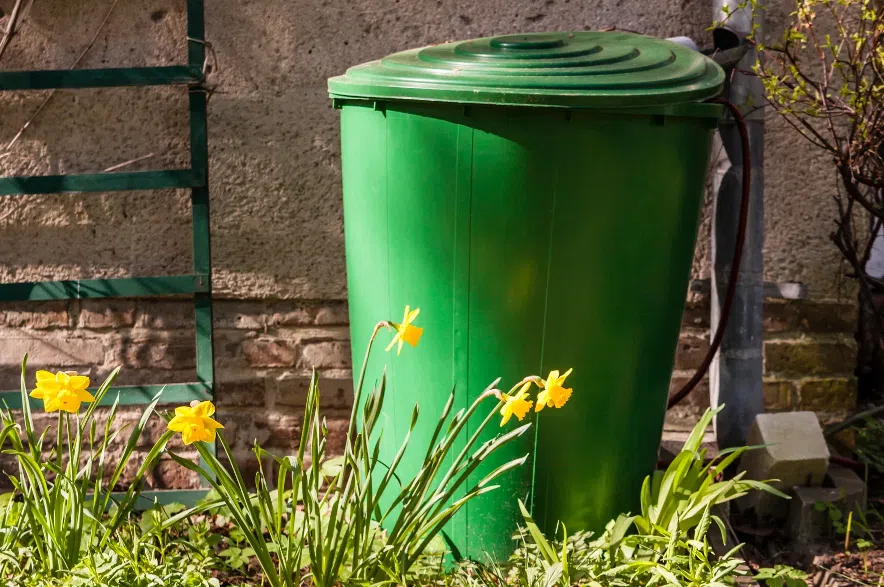Jill and Rick Van Duyvendyk answer all your gardening questions in Garden Talk on 650 CKOM and 980 CJME every Sunday morning at 9 a.m.
Here are some questions and answers from the May 25 show, which featured special guest Genevieve Russell, sustainability specialist with the City of Saskatoon, who talked about watering:
These questions and answers have been edited and condensed for clarity.
Q: Genevieve Russell, what does a sustainability specialist do?
Russell: My job involves overseeing the water conservation program. We have a conservation strategy to help us save save water in the community and in the city’s own operations, working towards reducing our our water use.
I help everyone save water, which saves on costs because every cubic meter of water you buy costs you something. Water takes a lot of energy to treat and distribute so it also helps lower our carbon footprint.
Water use doubles in the summer, which means we can put strain on our water system when we’re doing a lot of outdoor watering. So the water conservation strategy has specific goals to reduce that outdoor water use and keep the system working properly.
City of Saskatoon has some tips on its website at saskatoon.ca as well
Q: What do you recommend people do to save water?
Russell: Start with soil. Soil can really hold a lot of water, so having deep soil beds with lots of compost and other organics mixed in will help retain the moisture in
the soil and make it available for plants when they need it.
Add a layer, of mulch on top — organic mulch like wood mulch will also help lock in moisture. In newer neighborhoods, builders basically remove topsoil down to layers of clay so it’s up to the homeowner to resupply that topsoil. Don’t just go with a couple of inches, especially in the areas where you want flower beds or trees. At least 300 millimeters or over a foot and a half of soil will help and even two feet would be great.
A good thick layer of mulch without any landscape fabric will hold tons of moisture. The fabric can run the water off of the area rather than percolate it through because its so tightly woven.
Q: What is the City of Saskatoon’s rain barrel rebate?
Russell: Anybody — residents, schools, nonprofit organizations — can qualify for a $40 rebate on a rain barrel every year and we also have an income qualified rebate of $100 to for anyone with a leisure access or transit access pass.
Collecting rainwater is a great way to save drinking water and it’s also really good for your plants. There are lots of nutrients in rainwater that plants like.
Connect the rain barrel to a downspout. There’s lots of rain barrels on the market and they’ll have a lid and often a tap on the bottom you can hook up to a hose and feed your garden from there or just fill up watering cans. You can also build a larger tank to capture more of that water.
During the average year in Saskatoon, a 1,000 square foot roof on a house will capture enough rain to fill a 55 gallon rain barrel 110 to 125 times during the garden season.
Find more information on the rebate here.
Q: What else can people do to save water?
Russell: Rather than have a flat landscape put dips in your planting beds so they’ll hold water for a period of time. They don’t have to be deep dips, just enough to keep water long enough to soak into the soil.
Q: How much water should people use on lawns?
Russell: Water early in the day or in the evening to reduce evaporation, so more of that water is getting into the plants. Healthy soil will help soak up the water so it doesn’t run off.
We suggest a one inch of water per week. Watering deeply once a week is better than lots of daily shallow watering because we want the roots of the plants to go deeply and to be able to access more of that water. It’s also better for the trees that are planted in the lawn as well because then you’re not just watering the grass, you’re watering the trees deep as well.
Direct irrigation that trickles right into the soil and doesn’t spray up above will reduce how much water you’re losing to evaporation and it’ll get the water where where the plants want it.
Q: How do I grow Saskatoon berries?
A: You need at least two for pollination and they’ll do better in the ground. They won’t do very well in the wintertime here in a pot. Even in the summer, the roots get too hot in a pot. Most of the varieties will grow 10 to 12 feet high and almost that wide.
Q: What should I do with my lilac bush after flowering?
A: After it finishes blooming, cut back all the branches that have blooms. You can cut it down to three or four feet off the ground and then fertilize and let it come back, but you won’t get blooms for one or two years.
You can trim off the top and fertilize and water to get new growth and blooms will appear on that next year.
Q: How effective are fertilizer spikes for trees?
A: They work awesome as long as you water. It’s a slow release fertilizer, so if you don’t have irrigation, you’re relying on the rain to release it.
Put them evenly around the drip line and keep them moist and then they’ll release all summer long. You can’t just use a drip line, you’ve got to actually pour water over top of where the fertilizer is.
Q: What fertilizer should I use for watermelons?
A: Use compost or an organic vegetable fertilizer because you want micronutrients, calcium especially. One thing to be careful about is to watch overhead watering because you don’t want to get powdery mildew.
Don’t water over the leaves. The best way is drip irrigation or watering by hand at the base of the plant. The only way you can do it is overhead watering is to make sure you’re doing it in the morning when the sun’s up so it’ll evaporate the water sitting on the leaves.
Q: What’s the best time to prune my cotoneaster hedge?
A: You can trim it all through the summer. If you want to do a major pruning to a foot or two off the ground, then do it when it’s dormant, but treat it like a hedge and trim new growth as many times you want to keep it neat all summer.
Q: Should I water flowering apple and cherry trees?
A: Yes. Give them the equivalent of one inch per week of water, so if you put a sprinkler out there and a little dish you’ll be able to tell how much water you’re putting down. A deep watering once per month or every three weeks is good as well.
Q: I can’t get Cygon 2E anymore for the birch leaf miner. What’s a good substitute?
A: Call an arborist because they will have the registration to be able to do some systemic injection. You can’t buy it yourself, but an arborist can still get that chemical.
A lot of the birch trees can withstand a minor infestation so you want to create new growth to sustain it. Birches suck lots of water up. Keep the trees moist and fertilize around the drip line so you constantly get new growth.
Q: The leaves on my tomato plants are curled under and some are brown and dry on the ends. What happened?
A: Cool nights and adjustment can cause a bit of sunscale, so you’ve put them out in the hot sun when they’ve been a little bit sheltered you’ll might see that.
Keep your plants healthy, watch your watering and fertilize them. Sometimes we see a little bit of a nitrogen deficiency in tomato plants once we put them in the soil because the soil is all of a sudden leaching all the nutrients that that plant once had. So make sure you’re fertilizing them. Pinch off some of the leaves that are looking bad and let some new growth come in.
Q: How do I grow horseradish?
A: It will grow in just about any type of soil. A lot of people will put them in back alleys along the fence. They prefer a sandy soil though, with not too much moisture. It likes being a bit drier. You don’t want it wet all the time. It is a tuber in the ground.
Q: Can I plant Limelight hydrangeas as a hedge?
A: Watch the pH of your soil, you want it about 6 .5 to 7. Check the pH of your water too. Hydrangeas love sulfur and aluminum sulfate along with fertilizer.
Limelight grows about what about four and a half to five feet tall and then every once in a while you’ll get a year where you’ll get some tip kill so trim them up and they’ll grow right back again. Plant them about four feet apart. If you want them tighter quicker, then go three feet but not closer.
Cut them back at least 25 to 30 per cent in the spring and you’ll get a lot more flowers. In the fall, clean up all the blossoms so the snow doesn’t break the branches.
Q: My coleus look droopy, will they recover?
A: Yes. If they’re looking droopy, check the soil. Most likely they got cold and wet. TIf they were in a greenhouse and moved outside, they the stems can be weakened
Coleus love to be pruned and trimmed and they’ll actually be bushier and fuller So if you’re finding your plants a little bit weak, trim out about a third of your plant and then that will help bush it out and make it stronger as well.
Q: My apricot tree has patches of sap coming through the bark, some dark patches of bark around the branch joints and what looks like holes in the bark. Is this canker?
A: Apricots are susceptible to a canker where they’ll start weeping out of the main trunk and especially where you got some damage around the crotch. There’s no cure and it could spread so it is best to get rid of that tree. Try a plum tree in its place as they don’t get it as easy as apricots.
Read more:













